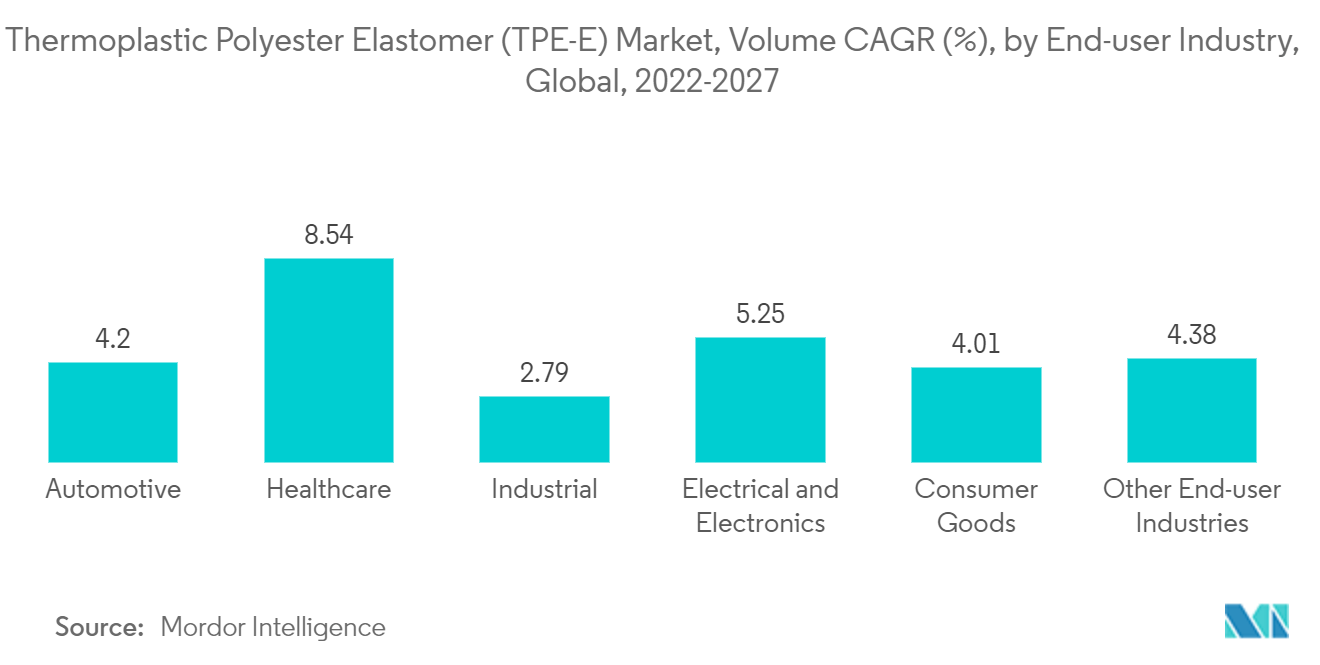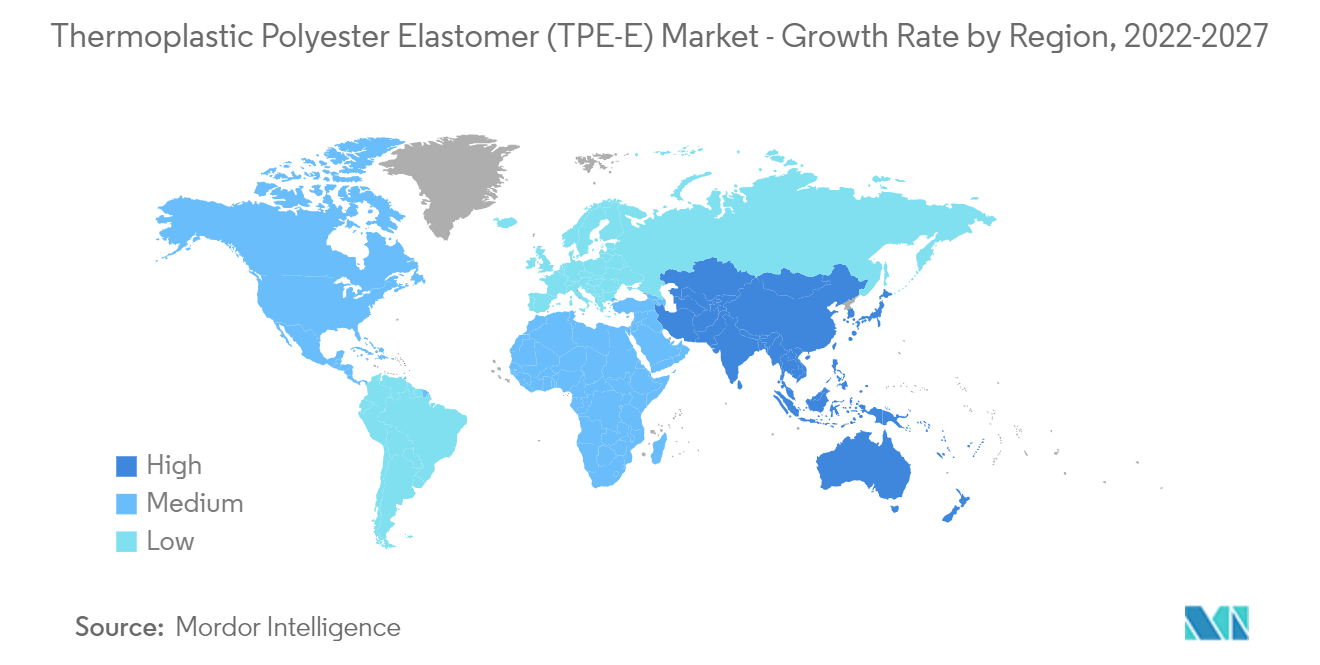Market Trends of Thermoplastic Polyester Elastomer (TPE-E) Industry
This section covers the major market trends shaping the Thermoplastic Polyester Elastomer Market according to our research experts:
Increasing Usage in the Automotive Industry
- Thermoplastic polyester elastomers (TPE-E) are high-performance materials whose application in the automotive industry has rapidly increased. TPE-E utilization in the automotive sector extends from the exterior and interior parts to engine components. The high durability, light weight, and cost-effectiveness of TPE-Es make them extremely coveted by automotive materials manufacturers.
- TPE-Es serve the automotive industry in several applications, some of which include the manufacturing of high-quality automotive instrument panels, CVJ boots, wheel covers, air intake ducting, airbag deployment doors, dashboard components, pillar trim, door liners and handles, seat backs, and seat belt components, among others.
- TPE-Es offer high design flexibility by being resistant to abrasion and vibration and dyeable in any desired color. They are highly durable in harsh weather conditions; hence they are preferred for internal mechanisms such as car locks. These properties also support the demand for long-term heat-resistant materials in electric vehicle fabrication.
- The automotive industry is working on utilizing lightweight materials for various vehicle applications. Hence, the growing automotive industry globally is expected to boost the demand for TPE-Es.
- According to OICA, the global sales of all vehicles in 2021 acoounted for 80,154,988 units, registering a growth of 3% as compared to 12,452,453 units sold in 2020.
- Vehicle scrappage policies are being implemented in India and China to scrap outdated vehicles and minimize pollution. It plans to cover 51 lakh light motor vehicles older than 20 years and 34 lakh light motor vehicles older than 15 years. This program aims to reduce pollution by phasing out obsolete or inoperable vehicles that do not have a valid fitness certificate. This approach will raise market demand for new cars.
- The global EV sales reached 675 million units in the entire year of 2021, 108% more as compared to the EV sales in 2020. This volume includes passenger vehicles, light trucks, and light commercial vehicles. The BEVs stood for 71% of total EV sales, while the PHEVs stood at 29% in 2021.
- According to the IEA, in 2030, global electric vehicle sales are expected to reach 125 million, per the New Policies Scenario (excluding two/three-wheelers). In the EV30@30 Scenario, in 2030, around 70% of vehicle sales in China are expected to be EVs. Also, as per the approximate sales value till now, EV sales in Europe was estimated at 50%, while it was 37% in Japan, 30% in Canada and the United States, and 29% in India.
- Therefore, owing to the above factors, the demand for TPE-E is expected to be impacted positively during the forecast period.

Asia-Pacific Region to Dominate the Market
- Asia-Pacific is expected to dominate the market. In the region, China is the largest economy in terms of GDP. China is one of the fastest emerging economies and has become one of the biggest production houses in the world today. The country's manufacturing sector is one of the primary contributors to the country's economy.
- China is the largest manufacturer of automobiles in the world. The country's automotive sector has been shaping up for product evolution, focusing on manufacturing products to ensure fuel economy while minimizing emissions, owing to the growing environmental concerns. In 2021, according to the OICA, the automotive production in the country reached 26.08 million, which increased by 3%, compared to 25.23 million vehicles produced in 2020, and is expected to grow up to 35 million vehicles by 2025. The increase in automotive production is estimated to drive the demand for thermoplastic polyester elastomers in the country from both EVs and IC engine vehicle manufacturing sectors.
- China has a well-established general industrial sector. According to the data published by China's National Bureau of Statistics, the country's value-added industrial output went up 9.6% Year-on-Year in 2021. The country's industrial output grew 4.3% Y-o-Y in December 2021 (a 0.42 % increase from November), thereby increasing the demand for thermoplastic polyester elastomers in the country.
- China has one of the world's largest electronics production bases and offers tough competition to the existing upstream producers, such as South Korea, Singapore, and Taiwan. Electronic products, such as smartphones, OLED TVs, and tablets, have the highest growth rates in the consumer electronics segment of the market in terms of demand. Economic development in China and improving living standards among the population drive the demand for electronic goods.
- The continuous growth of income resulted in the rise in the population's per capita disposable income, which is expected to benefit the demand for electronic goods in China. The expansion of the middle class and high-income population group is expected to propel the demand for electronics. According to the National Bureau of Statistics of China, the revenue in the consumer electronics and household appliances segment reached CNY 934.64 million (approx. USD 131.27 million) in 2021. The revenue is expected to show an annual growth rate of 2.04%, resulting in a projected market volume of USD 175,670 million by 2025.
- Further, in India, as per OICA, around 4,399,112 vehicles were produced in 2021, which increased by 30%, comparison to 3,381,819 units manufactured in 2020.
- Also, the healthcare sector in the country is expected to reach USD 372 billion by 2022, mainly driven by increasing health awareness, access to insurance, rising income, and diseases. The medical sector in India is benefiting from the growing population at a rate of 1.6 % per year.
- India has witnessed rapid growth in the industrial sector in recent years. The index of industrial production (IIP) in India increased from 111.7 in 2020-21 to 128.7 in the 2021-22 period. This growth is also supported by various government initiatives like the National Manufacturing Policy (which aims to increase the share of manufacturing in GDP to 25% by 2025) and the PLI scheme for manufacturing (which was launched in 2022), thereby increasing the demand for thermoplastic polyester elastomers in the country.
- According to the India Brand Equity Foundation (IBEF), the Indian electronics manufacturing industry is expected to reach USD 520 billion by 2025. Electrical and electronics production in India is expected to increase rapidly due to government initiatives with policies, such as Make in India, the National Policy of Electronics, Net Zero Imports in Electronics, and the Zero Defect Zero Effect. Such policies offer a commitment to growth in domestic manufacturing, lowering import dependence and energizing exports and manufacturing, like the 'Make in India' program, to make the country self-reliant.
- Due to all such factors, the market for thermoplastic polyester elastomer in the region is expected to have a steady growth during the forecast period.


